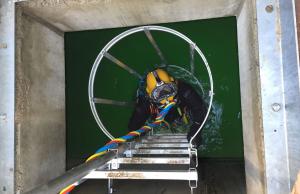Into the depths
The hot and cold basins that are part of the ITER heat rejection system are equivalent in volume to half a dozen Olympic pools. When filled to capacity, the pressure exerted by the water on the bottom slab, walls and joints of the concrete structure is considerable. In mid-October an "assessment of tightness" was performed, during which the basins were "overfilled" with 27,000 m³ of water (7,000 m³ more than their operational volume).
Under the tremendous pressure exerted by 27,000 tonnes of water, the basins incurred the expected deformations—in the range of 4 to 6 millimetres—before settling. However, operators needed to confirm that no cracks had occurred in the critical zones of the concrete structure such as corners and joints.
And for this, there was only one option: sending a diver into the depths of the basins to see with his own eyes and report back. The operation lasted five days in late November... when even the "hot" basin was extremely cold.


